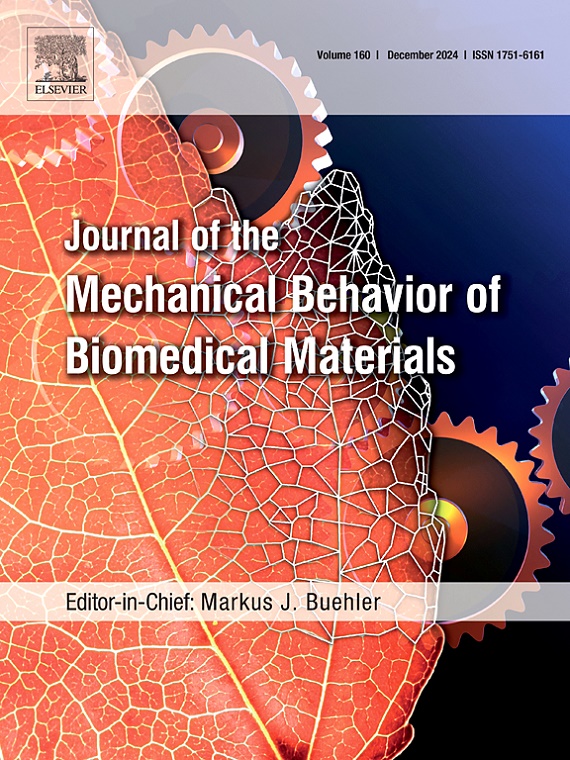Tuning the mechanical properties of alginate dialdehyde–gelatin (ADA–GEL) bioinks for bioprinting approaches by varying the degree of oxidation
IF 3.3
2区 医学
Q2 ENGINEERING, BIOMEDICAL
Journal of the Mechanical Behavior of Biomedical Materials
Pub Date : 2024-12-28
DOI:10.1016/j.jmbbm.2024.106871
引用次数: 0
Abstract
Extrusion-based 3D bioprinting is one of the most promising and widely used technologies in bioprinting. However, the development of bioprintable, biocompatible bioinks with tailored mechanical and biological properties remains a major challenge in this field. Alginate dialdehyde–gelatin (ADA–GEL) hydrogels face these difficulties and enable to tune the mechanical properties depending on the degree of oxidation ( DO) of ADA. Here, we present a holistic approach for characterizing the influence of the DO on the mechanical properties of ADA–GEL hydrogels under multiple loading modes, compression, tension, and torsional shear in the large-strain regime. We evaluate complex mechanical characteristics including nonlinearity, hysteresis, conditioning, and stress relaxation. We calibrate hyperelastic material models to determine the corresponding material parameters inversely. Our results confirm that decreasing the DO of ionically crosslinked ADA–GEL hydrogels leads to an increase in stiffness, more distinct nonlinearity, more pronounced hysteresis, and minor preconditioning effects, while the relaxation behavior is slightly affected. The fabrication technique – molding or printing – does only slightly affect the complex mechanical properties and stress relaxation behavior. Ionically and enzymatically dual-crosslinked ADA–GEL hydrogels showed higher stresses during cyclic loading and less viscous effects during stress relaxation in all three loading modes. We conclude that the DO and the crosslinking procedure are crucial parameters to tune the mechanical behavior of ADA–GEL hydrogels. Careful choice of these parameters might facilitate the fabrication of biomaterials that closely mimic the properties of native tissues for advanced tissue engineering applications.
求助全文
约1分钟内获得全文
求助全文
来源期刊

Journal of the Mechanical Behavior of Biomedical Materials
工程技术-材料科学:生物材料
CiteScore
7.20
自引率
7.70%
发文量
505
审稿时长
46 days
期刊介绍:
The Journal of the Mechanical Behavior of Biomedical Materials is concerned with the mechanical deformation, damage and failure under applied forces, of biological material (at the tissue, cellular and molecular levels) and of biomaterials, i.e. those materials which are designed to mimic or replace biological materials.
The primary focus of the journal is the synthesis of materials science, biology, and medical and dental science. Reports of fundamental scientific investigations are welcome, as are articles concerned with the practical application of materials in medical devices. Both experimental and theoretical work is of interest; theoretical papers will normally include comparison of predictions with experimental data, though we recognize that this may not always be appropriate. The journal also publishes technical notes concerned with emerging experimental or theoretical techniques, letters to the editor and, by invitation, review articles and papers describing existing techniques for the benefit of an interdisciplinary readership.
 求助内容:
求助内容: 应助结果提醒方式:
应助结果提醒方式:


